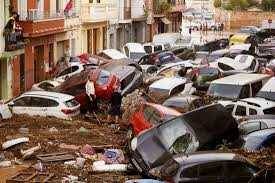The Flood in Valencia: A Historical Perspective and Recent Events
Valencia, a city renowned for its rich cultural heritage and stunning architecture, has faced numerous challenges throughout its history. Among these challenges, flooding stands out as a significant threat, impacting both its urban landscape and its residents. Recent flood events have highlighted the vulnerability of this Mediterranean city, prompting discussions about infrastructure, climate change, and urban planning.
Historical Context
Valencia's geographical location contributes to its susceptibility to flooding. Situated near the Turia River and the Mediterranean coast, the city has a long history of dealing with the consequences of heavy rainfall and river overflow. Historical records indicate that severe floods have occurred periodically, with some of the most devastating events documented in the 20th century. The catastrophic flood of 1957 remains a pivotal moment in Valencia’s history, where torrential rains caused the Turia River to overflow, leading to widespread destruction and loss of life.
In response to past disasters, significant measures were taken to mitigate flooding risks. The diversion of the Turia River, which involved transforming the riverbed into a park, was one of the most notable interventions. This project not only aimed to prevent future floods but also revitalized the city, creating green spaces and recreational areas.
Recent Flood Events
In recent years, Valencia has experienced several flood events that raised alarms about the effectiveness of existing flood management strategies. The heavy rains in October 2020 resulted in significant flooding in several neighborhoods, causing damage to homes, businesses, and infrastructure. Streets turned into rivers, and emergency services were inundated with calls for assistance. The event served as a stark reminder of the city’s vulnerability and the urgent need for improved flood management systems.
Meteorological changes and climate variability have been identified as significant factors contributing to the increased frequency and intensity of flooding. As global temperatures rise, extreme weather events are becoming more common, leading to sudden and heavy downpours that overwhelm drainage systems. In Valencia, this trend is particularly concerning, as the city must balance urban development with sustainable environmental practices.
Infrastructure and Mitigation Efforts
In light of recent flooding incidents, local authorities have been prompted to reassess their infrastructure and emergency response strategies. The government has invested in modernizing drainage systems, enhancing flood defenses, and implementing early warning systems. These measures aim to ensure that the city can respond effectively to heavy rainfall and mitigate the impact on its residents.
Moreover, urban planning initiatives have been re-evaluated to prioritize green infrastructure, such as permeable surfaces and green roofs, which can absorb rainfall and reduce runoff. By integrating these sustainable practices into the urban landscape, Valencia aims to enhance its resilience against future flooding.
Community Response and Awareness
The community’s response to flooding has also evolved, with increased awareness about the risks associated with heavy rains. Local organizations and residents are becoming more proactive in advocating for sustainable practices and better flood management. Educational campaigns about flood preparedness and response are gaining traction, empowering citizens to take action and be better prepared for potential emergencies.
Conclusion
The history of flooding in Valencia serves as both a warning and a guide for future urban development and disaster management. As the city continues to confront the challenges posed by climate change, it must prioritize sustainable infrastructure and community awareness. Through collaborative efforts between government, organizations, and residents, Valencia can build a resilient future, ensuring that its rich cultural heritage and vibrant communities endure despite the threat of flooding. The lessons learned from past events will be crucial in shaping a safer, more sustainable urban environment for generations to come.


